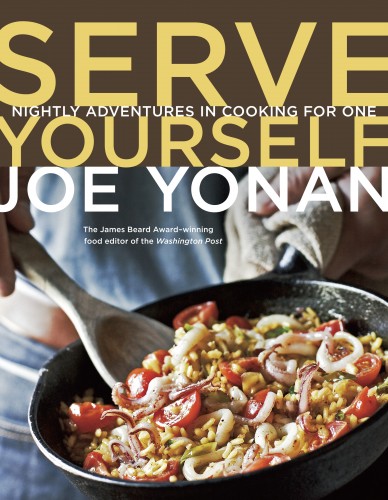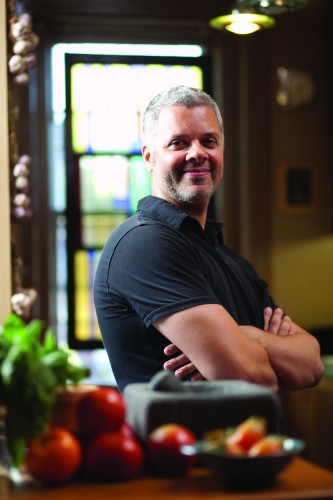All too often cooking for oneself is treated as little more than a necessary evil. But cooking solo doesn’t need to be a chore. It can be a pleasure and an art. After all, as Joe Yonan, the award-winning food editor for the Washington Post, writes in his new cookbook, Serve Yourself: Nightly Adventures in Cooking for One, “If you don’t feed yourself well, who will?”
The book offers a delicious array of dishes that will have you feeding yourself very well indeed. Yonan knows his subject and from more than personal experience. He’s been writng a column called “Cooking For One” at the Post for several years. His book features sophisticated recipes for chutneys, fruit jams, frittatas, Yucatan slow-roasted pork, a mouthwatering assortment of tacos (with homemade tortillas, and a spicy coconut sorbet.
In addition, there are helpful shopping tips and a guide to stocking and storing ingredients geared for the single chef, but which are useful to pretty much any cook.
I caught up with Yonan by email recently to ask him about the book and the challenges and joys of cooking for oneself.
PRK: How did you first come up with the idea for the “Cooking for One” column and why, as editor, did you decide to write it yourself? What appealed about the subject?
JY: Deputy editor Bonnie Benwick and I had been tossing around the idea of a CF1 column after regularly fielding questions about the topic, and decided to pull the trigger after the great Judith Jones mentioned that she’d be willing to contribute to it. We started out having different voices — Judith went first, writing about how she likes to set a place setting for herself, use nice linens, and such; I followed up by writing about how I like to make tacos to eat in front of the TV while I watch “American Idol.” Very different.
After about six months, though, I found myself wanting to contribute to it more and more and, eventually, I decided to own it because I feel so strongly about the message I want to spread: that it’s not about merely getting over the challenges of cooking for yourself, but also about learning to appreciate how much fun and even freeing it can be.
PRK: What was the process of putting together this cookbook like? Was it very different from writing recipes for the column?
JY: It was a blast, especially when I took a month-long leave and was able to devote all my time to it. Compared to the column, many more of these recipes are based on memories of things I ate and cooked as a child, or as a just-out-on-my-own college student or young professional.
The column tends to be thematic: recipes that showcase a particular point about CF1 I was trying to make, but I was limited to just a few recipes per column. Many of those columns ended up being the backbone of chapters. I was lucky enough to work with an editor and publisher that supported my eclectic choice of chapter divisions, which meant that I got to develop recipes for a whole raft of pizzas and tacos, for instance, rather than just a handful.
PRK: One of the things that struck me, as I read through the book, was that while many cookbooks geared towards people who cook for themselves seem to view that as a liability, you emphasize the opportunities that cooking solo open up. What do you see as the positive aspects of cooking for one, and what do you find most enjoyable and/or satisfying about it?
JY: I didn’t want to make apologies for it, or to overemphasize all the struggles, indeed, so I’m glad you picked that up. So often, when you ask people whether they cook for themselves, they inevitably use the word “bother,” as in, “Why would I bother, when it’s just for me?” I always think to myself, or sometimes say out loud, “Why WOULDN’T you?” I love cooking for other people, but nobody’s more important, I’m afraid.
The way I look at it, when you’re alone in the kitchen there’s nobody else’s palate or dietary restrictions or allergies or quirks to consider — and there’s nobody there to judge you. So not only is the pressure off (no performance anxiety!), you can follow whatever quirky cravings you might be having and satisfy them without having to apologize for it. As gratifying as it is to cook for a dinner party (I love compliments as much as anyone) and for loved ones, it’s fulfilling in a different way to know that you’re capable of taking care of yourself through cooking, too.
I’m also one of those people who find cooking positively meditative and soothing, especially when it’s for myself. So on my walk home at the end of a busy day I’m immediately starting to decompress by imagining my fridge, freezer and pantry and starting to put ideas together for what I might make. If I don’t have to pick up anything at the store to supplement, all the better.
PRK: In what ways are the challenges that face a person cooking for him/herself different from those facing a chef cooking for two or more?
Shopping is harder, because so many items — particularly fresh produce — don’t come in single-friendly sizes. Have you bought celery lately? So that leads to a greater risk of waste. And the stakes are higher when it comes to leftovers. Since most recipes serve at least four, if someone cooking for two makes one of those dishes, the two of them will have one night of leftovers. If I make that dish, I’ll be faced with three nights of leftovers.
I encourage people to turn the idea of leftovers on its head by sometimes making ingredients rather than full-fledged dishes. So you make a pot of beans and many cups of brown rice when you have a little more time on the weekend, then you freeze them in small portions and thaw and use in weeknight dishes that come together quickly because you’ve planned a little bit.
PRK: There are some really delicious-looking recipes in the book — the tacos are particularly enticing. If you wanted to share with another, how difficult is it to scale the recipes up to serve more people?
JY: Well, first of all, my portions are pretty generous, so in many cases you could probably easily stretch a recipe to serve two if you added a side dish or salad. Generally, though, it’s very easy to double a recipe that serves one, much easier than it is to divide something by four or six. Some of the tacos depend on great things like pickled onions or kimchi that you’ve made in advance, anyway, so to increase the yield is merely a matter of making a little more of the bulk of the fillings. The Korean short-rib tacos call for enough short ribs for several meals, so there’s one that would be easy to extend right off the bat.
PRK: Do you have a favorite recipe from the book?
JY: That’s like asking a father to pick his favorite child! OK, if you force me to choose, Sophie-like, then I’ll go with the Pastoral Tacos, partly because they were part of the first “Cooking for One” column I wrote for the Post, but also because I have such great memories of their inspiration, tacos al pastor, in Mexico City. They rock.
Joe was kind enough to share the recipe for his beloved Pastoral Tacos. It takes things to a whole other realm if you make your own tortillas. They are surprisingly simple to make.
Pastoral Tacos
- 3 (2-ounce) pork cutlets, trimmed of excess fat (or substitute a 6-ounce boneless center-cut pork chop)
- 1 tablespoon distilled white vinegar
- 2 tablespoons fresh pineapple juice
- 1/2 teaspoon pimenton (smoked Spanish paprika)
- 1/2 teaspoon crumbled dried pasilla or ancho chile (or substitute red pepper flakes)
- 1/2 teaspoon kosher or coarse sea salt, plus more to taste
- 1/2 teaspoon freshly ground black pepper
- 1/2 cup fresh pineapple chunks, cut into 1/2-inch cubes
- 1 tablespoon chopped fresh cilantro leaves
- 1 large shallot lobe, finely chopped
- 1/2 medium jalapeño chile, stemmed, seeded, and chopped
- 1/2 lime
- 3 corn tortillas, preferably homemade
- 1 teaspoon extra-virgin olive oil
Place each pork cutlet between two pieces of plastic wrap and pound to a thickness of about 1/8 inch.
(If you are using a boneless center-cut pork chop, first steady it flat on the cutting board with one hand and then, with the knife parallel to the cutting board, slice it into thirds horizontally. Then place each third between two pieces of plastic wrap and pound to 1/8 inch thick.)
Combine the vinegar, pineapple juice, pimenton, chile, salt and pepper in a large resealable plastic food storage bag; mix well, then add the cutlets. Press the air out of the bag and seal; massage the marinade into the meat. Let sit for at least 10 minutes or up to an hour, while you make the salsa and warm the tortillas.
Combine the pineapple, cilantro, shallot and jalapeño in a small bowl. Squeeze the lime juice into the bowl. Add salt to taste and mix well.
Warm the tortillas and wrap them in aluminum foil to keep warm.
Pour the oil into a large skillet set over medium-high heat. When it starts to shimmer, remove the cutlets from the marinade, shake off any excess, and place in the skillet. Sprinkle lightly with a little more salt, then cook until lightly browned on one side, 1 to 2 minutes. Turn them over, sprinkle lightly with salt, and cook until browned on the other side and just cooked throughout, another 1 to 2 minutes. Turn off the heat and let the cutlets rest for a minute.
Lay the tortillas out on a plate. Place one cutlet on each tortilla. Top each with pineapple salsa, and eat.
Note: If your pork is too firm or chewy to easily fold up whole in the tortilla, feel free to cut it into strips or chunks.
(Reprinted with permission from Serve Yourself: Nightly Adventures in Cooking for One by Joe Yonan copyright © 2011. Published by Ten Speed Press, a division of Random House, Inc.)
Note to our readers: Joe Yonan will be in Boston this week for a trio of book-related events. On April 9 at 10 a.m. he’ll host a demonstration and book-signing at the Cambridge School of Culinary Arts. On April 11 he’ll do another demo at Northeastern, which is free, but for students only. That same day there will be a reception and 6-course dinner, featuring dishes from the book prepared by chef Andy Husbands at Tremont 647, starting at 6 p.m.
You can find more information about these events on Joe Yonan’s website.



Thanks, Joe, for casting off the tired old notion that a singleton doesn’t deserve the same – or better! – culinary pleasures. I look forward to cooking, whether it’s for me, a pal or a crowd. Tonight: Shrimp and grits with wilted greens.